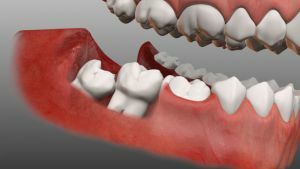 Retinished tooth is a dental pathology, in which a fully formed tooth does not fully erupt from the gum.
Retinished tooth is a dental pathology, in which a fully formed tooth does not fully erupt from the gum.
The status of a retouched tooth can receive a wisdom tooth, premolars, a permanent canine or a milk tooth that lingers in eruption.
The main reasons for the appearance of retention include improper insertion of the tooth rudiments in the embryonic period, deviations in the development of the anatomical part of the jaw, in which teeth are formed, premature removal of milk teeth, diseases of connective tissues and follicles.
Retinning teeth can occur due to the presence of hereditary anatomical features or depending on the condition of the body.
The reasons for such a violation are different, however, as practice shows, tooth retinitis often occurs due to early loss of milk teeth.
The main success in the treatment of retention is correct diagnosis, which contributes to the correct choice of surgical technique. Successful surgery will correct the situation using a bracket system or by removal.
Contents
- Wisdom tooth retention
- Why is retention often accompanied by a dystopia?
- What is Dystopia?
- Clinical picture of abnormal location and development of teeth
- What should be done depending on the complexity of the situation?
- When it is necessary to remove
- Surgery
- Possible complications
Retention of wisdom tooth
When teething wisdom is experienced, many experience acute and aching pain, and the focus of inflammation in this case can be identified
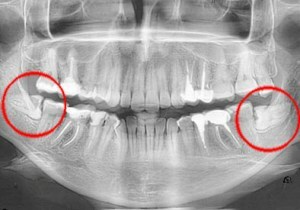
In the photo, the retarded wisdom tooth on x-ray
itself. If you feel unwell or fever, it is possible that this can be caused by a retracted wisdom tooth.
The process of treating eights is always a challenge, as it is very difficult to get to the wise tooth and they have a complex root structure.
In addition, the wisdom teeth, which have not yet been cut completely, are half covered with the gum, which contributes to the accumulation of pathogens in this area. Without a thorough and timely cleaning of these teeth, their circumference becomes fouled, which leads to caries and other diseases.
If the tooth is misplaced, it exerts pressure on adjacent teeth, which may be bent. Therefore, wisdom teeth are often recommended to remove, rather than treat.
Why is retention often accompanied by a dystopia?
Because the retina is a pathological process during which the tooth can not completely erupt, the retention is associated with incomplete incision. This, in turn, can be due to the initially anomalous arrangement of the tooth and its subsequent growth in the wrong direction.
Perhaps the anomalous location of the reniform tooth may be due to a delay in the replacement of a nearby tooth that interferes or stops the further eruption and growth of the adjacent tooth.
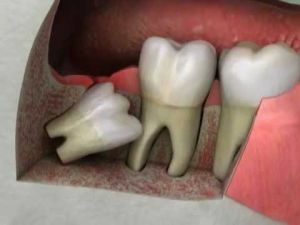 Very rarely, however, an abnormal position of the renated tooth is initially encountered, the full eruption of which may be interfered by too dense gum tissue or due to an insufficient amount of space in the jaw.
Very rarely, however, an abnormal position of the renated tooth is initially encountered, the full eruption of which may be interfered by too dense gum tissue or due to an insufficient amount of space in the jaw.
These causes are prerequisites for abnormal tooth growth, during which it curves, tilts and can move as the eruption. In these cases, a dystopia of the renated tooth takes place.
What is Dystopia?
Another type of dental pathology is the anomalous location of the tooth in an atypical place for it. Such teeth may be inclined, rotated around their axis or occupy their place in the dental arch, but this causes complications in the process of their improper growth.
This anomaly is called a dystopia and can be not only innate, but also acquired character.
The causes of dystopia development can be trauma, slow growth of the jaw, belated loss of milk teeth. This problem is most often found in adolescents, although there are cases of the appearance of dystopic teeth in adults.
Dental retention can be further complicated by dystopia. This situation occurs when an obstacle arises on the natural pathway to the eruption of the tooth. This changes not only the correct position of the tooth, but there is a deviation from the norm in the process of their growth. Suffer from this anomaly can not only root, but also simple teeth.
Retinished dystopic tooth brings a person considerable discomfort and can worsen his condition. So, very often teeth with such an anomaly cause inflammation of the gums, so close to it the muscle tissue swells. In addition, the displacement of one tooth is accompanied by the displacement of the rest.
Clinical picture of abnormal location and development of the teeth
Often, the renamed teeth do not bring any discomfort to their owner and can be detected only during the 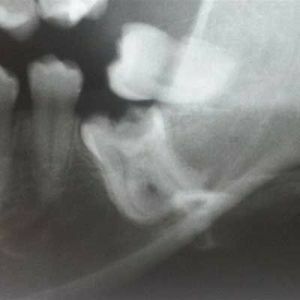 X-ray study.
X-ray study.
Clinical picture of this kind of deviation is the absence of molar tooth in a certain place of the dental arch and the presence of milk. This leads to a change in the position of the adjacent teeth and affects the development of a proper bite.
In order to reveal a re-formed molar tooth, the thickening of the crown or the proximity of the tooth in the alveolar region can be palpated. Perhaps, there is a minor inflammation or numbness in this place.
Distant teeth also affect the course of development and the location of the remaining teeth. In addition, the development of an incorrect bite is supplemented by significant aesthetic and functional deficiencies.
Unevenness in the eruption of such teeth can lead to the development of decubital ulcers, which lead to pathological processes in the blood supply of the oral cavity and cause inflammation of the surrounding tissues.
The clinical picture of the renamed dystopic teeth at their incorrect position is represented by the presence of numerous wounds and ulcers in the case of a tooth tilt in the buccal side.
This situation contributes to the development of purulent process. Eating becomes painful, hygienic care is not possible due to the soreness of the surrounding tissues.
In the future such a situation can lead not only to the appearance of caries, inflammatory processes, toothache, but also the development of much more serious diseases of the mouth and teeth.
What should I do, depending on the complexity of the situation?
If any abnormalities are found during germination, the dentist should be consulted. Self-treatment here does not help in any way. Only a qualified specialist can correctly diagnose an anomaly, assess the situation and determine the question - it is necessary to treat the tooth or better to remove it.
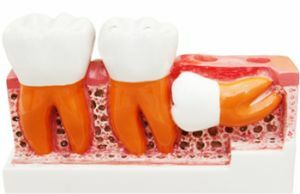 The earlier this deviation was noticed, the more likely it is that the tooth can be cured. The best way to orthodontic treatment is dystopic or renotated dystopic teeth, whose anomalies were noticed as early as adolescence.
The earlier this deviation was noticed, the more likely it is that the tooth can be cured. The best way to orthodontic treatment is dystopic or renotated dystopic teeth, whose anomalies were noticed as early as adolescence.
Depending on the nature of the development of the teeth, the variety and degree of development of the anomaly, appropriate treatment is prescribed. If it is a matter of wisdom teeth, then in most cases they decide to remove it, since there are difficulties in treatment.
Dystopia of canines is treated by removing the second tooth while retaining the bite. In most cases, I use braces to balance the anomalies.
With the complete absence of any tooth, there may be a question of prosthetics or cosmetic transformation of neighboring specimens. If there is no possibility to conduct treatment, and there are a number of contraindications, then such teeth are subject to removal.
When it is necessary to remove
Removal of the renated and dystopic teeth is performed if there are a number of contraindications to their treatment. This method of treatment is the most common in the case of wisdom tooth treatment.
In addition, pain in the teeth and gums, swelling in the mouth, headache, numbness of the muscles, damage to the rest of the teeth, development of diseases of the mouth and the risk of damaging good teeth during their treatment are the most powerful reasons for removing abnormal teeth.
Surgical intervention
Depending on the location of the rilled tooth, the degree of complexity of the operation is determined. The process of removal necessarily undergoes anesthesia, since surgery of this kind involves surgical intervention.
To begin with, necessary cuts are made, a hole is drilled in the bone, which makes it possible to pull out the tooth. If the tooth is large enough, then its extraction takes place in several stages.
In the resulting hole, the doctor lays out special medications. If it is too large, then it must be sewn. After the operation, a long recovery period follows.

The process of removing a dystopic tooth is somewhat different from the procedure for removal of the repaired tooth, as it is hidden under the gum or bone surface.
To remove it, it is also necessary to make incisions with the scalpel and remove that part of the gum under which it was hiding. If it is a bone thick tissue, then for its drilling a surgical burr is used. At the end of the operation, sharp edges of the awn are smoothed out, the wound cavity is processed and stitched.
A laser beam or any other ultrasound surgical device used in dentistry can be used instead of a scalpel.
Possible complications of
The success of treatment depends not only on the quality of the operation performed, but also on the correctness of postoperative care. The appearance of edema and the presence of pain within a few weeks after surgery is the norm, however, edema should pass within a week. To remove the swelling apply traditional medicine.
After tooth extraction, do not take hot food or rinse the mouth immediately, as the hole becomes dry.
In addition, in order not to provoke bleeding it is necessary to refuse brushing teeth and taking hard food. The patient experiences acute and dull pain, which is accompanied by an unpleasant aftertaste in the mouth.
To avoid this effect, tampons with special ointment are applied to the socket.
Continuous bleeding, nerve trauma, numbness of individual parts of the oral cavity, difficulty opening the mouth, 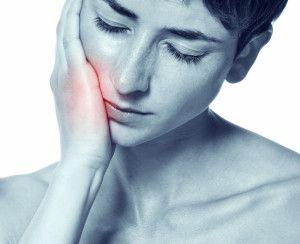 damage to adjacent teeth and jaw, the presence of an inflammatory process on healthy tissues - these are serious abnormalities that may occur during tooth extraction.
damage to adjacent teeth and jaw, the presence of an inflammatory process on healthy tissues - these are serious abnormalities that may occur during tooth extraction.
In any case, the course of treatment and recovery should be supervised by a dentist.
Some features of teething can be the reason for the appearance of the renated and dystopic teeth. These anomalies can manifest themselves either separately or combined with each other.
The clinical picture is general, but in each case has its own peculiarities. Depending on the complexity of the situation, treatment or removal of the teeth may be expected.
In case of complications, immediately consult a doctor.
